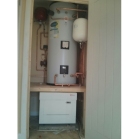Heat pumps act like heat-interface units on ground-source scheme

Kensa Shoebox water-source heat pumps (pictured) served by a micro ground-source district heating systems have been installed in eight homes in Shropshire. There is no mains gas, and this project for Shropshire Rural Housing Association comprises eight new-build semi-detached houses and detached bungalows. It is next to a cluster of eight other properties that had a similar systems installed 15 months ago.
Ian Richardson, chief executive of Shropshire Rural Housing Association, explains, ‘We how have more than a third of our homes getting their heating and domestic hot water in this way — whether through retrofitting or incorporating the ground-source heat pump into new homes.
Each home in the latest project has its own 6 kW Shoebox heat pump connected to one of three communal borehole arrays. Each home has independent control of its heating and billing.
One borehole serves two properties, and two pairs of boreholes each serve three properties. The Installations are eligible for generous payments through the non-domestic Renewable Heat Incentive because of their ‘district’ nature.
The flexibility of the design of the micro ground-source heat networks enabled the installation to be fitted with the progress of the build. Employing a diversity factor across the arrays means that fewer deeper boreholes are required compared to individual boreholes connected to individual heat pumps.








